HONDA CIVIC COUPE 1999 Owners Manual
Manufacturer: HONDA, Model Year: 1999, Model line: CIVIC COUPE, Model: HONDA CIVIC COUPE 1999Pages: 269, PDF Size: 2.42 MB
Page 181 of 269
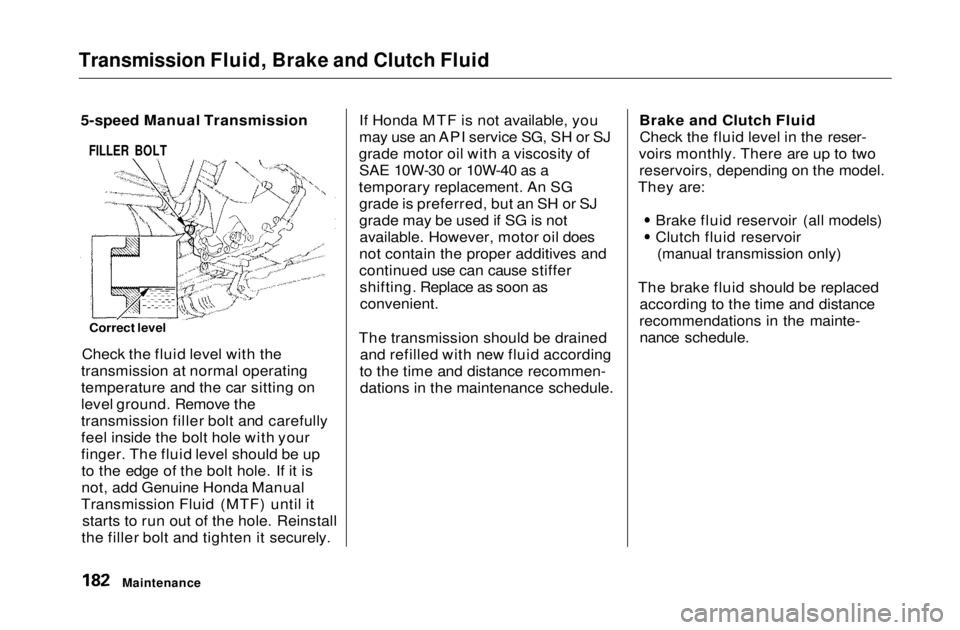
Transmission Fluid, Brake and Clutch Fluid
5-speed Manual Transmission
FILLER BOLT
Correct level
Check the fluid level with the
transmission at normal operating
temperature and the car sitting on
level ground. Remove the
transmission filler bolt and carefully
feel inside the bolt hole with your
finger. The fluid level should be up to the edge of the bolt hole. If it is
not, add Genuine Honda Manual
Transmission Fluid (MTF) until it starts to run out of the hole. Reinstall
the filler bolt and tighten it securely. If Honda MTF is not available, you
may use an API service SG, SH or SJ
grade motor oil with a viscosity of SAE 10W-30 or 10W-40 as a
temporary replacement. An SG grade is preferred, but an SH or SJ
grade may be used if SG is notavailable. However, motor oil does
not contain the proper additives and
continued use can cause stiffer shifting. Replace as soon asconvenient.
The transmission should be drained and refilled with new fluid according
to the time and distance recommen- dations in the maintenance schedule. Brake and Clutch Fluid
Check the fluid level in the reser-
voirs monthly. There are up to two reservoirs, depending on the model.
They are:
Brake fluid reservoir (all models) Clutch fluid reservoir
(manual transmission only)
The brake fluid should be replaced according to the time and distance
recommendations in the mainte- nance schedule.
MaintenanceMain Menu Table of Contents s t
Page 182 of 269
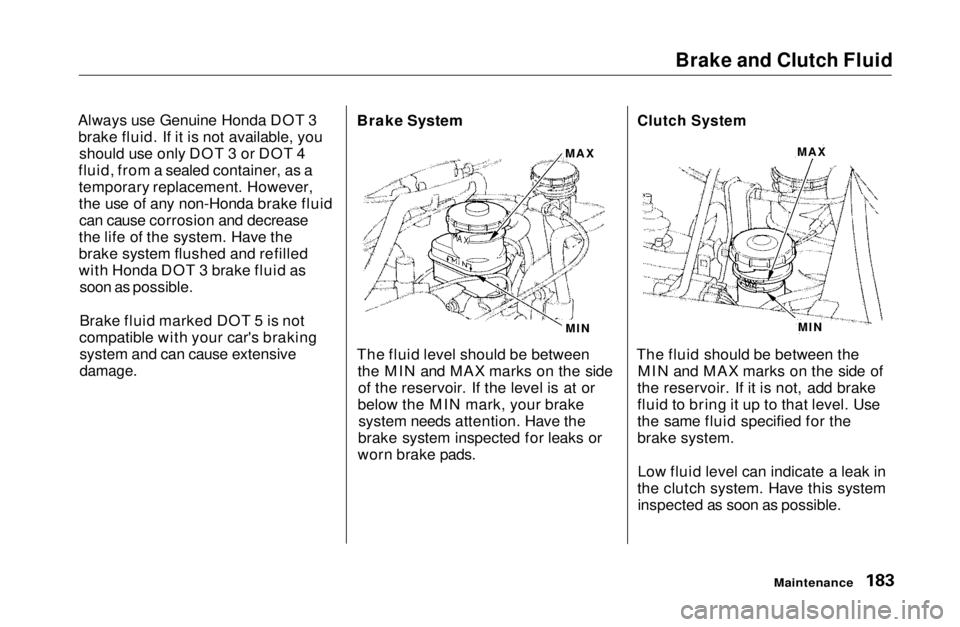
Brake and Clutch Fluid
Always use Genuine Honda DOT 3 brake fluid. If it is not available, you should use only DOT 3 or DOT 4
fluid, from a sealed container, as a temporary replacement. However,
the use of any non-Honda brake fluidcan cause corrosion and decrease
the life of the system. Have the
brake system flushed and refilled
with Honda DOT 3 brake fluid as soon as possible.
Brake fluid marked DOT 5 is not
compatible with your car's braking system and can cause extensive
damage.
Brake System
MIN
The fluid level should be between the MIN and MAX marks on the sideof the reservoir. If the level is at or
below the MIN mark, your brake system needs attention. Have the
brake system inspected for leaks or
worn brake pads.
Clutch System
The fluid should be between the MIN and MAX marks on the side of
the reservoir. If it is not, add brake
fluid to bring it up to that level. Use
the same fluid specified for the
brake system.
Low fluid level can indicate a leak in
the clutch system. Have this system inspected as soon as possible.
Maintenance
MAX
MAX
MINMain Menu Table of Contents s t
Page 183 of 269
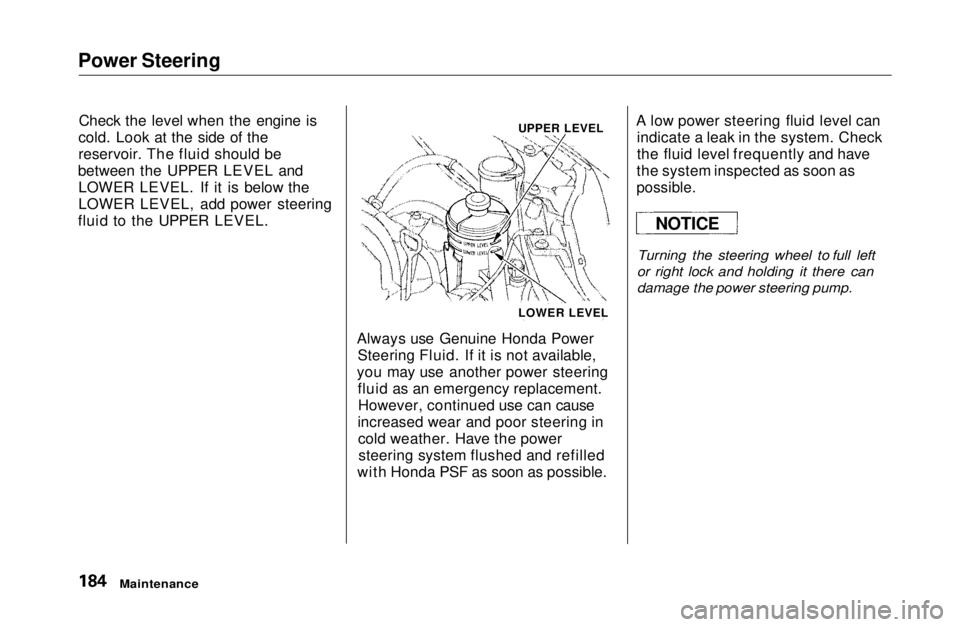
Power Steering
Check the level when the engine is
cold. Look at the side of the
reservoir. The fluid should be
between the UPPER LEVEL and LOWER LEVEL. If it is below the
LOWER LEVEL, add power steering
fluid to the UPPER LEVEL.
Always use Genuine Honda PowerSteering Fluid. If it is not available,
you may use another power steering fluid as an emergency replacement.However, continued use can cause
increased wear and poor steering in cold weather. Have the powersteering system flushed and refilled
with Honda PSF as soon as possible. A low power steering fluid level can
indicate a leak in the system. Check
the fluid level frequently and have
the system inspected as soon as
possible.
Turning the steering wheel to full left
or right lock and holding it there can
damage the power steering pump.
Maintenance
NOTICE
UPPER LEVEL
LOWER LEVELMain Menu Table of Contents s t
Page 184 of 269
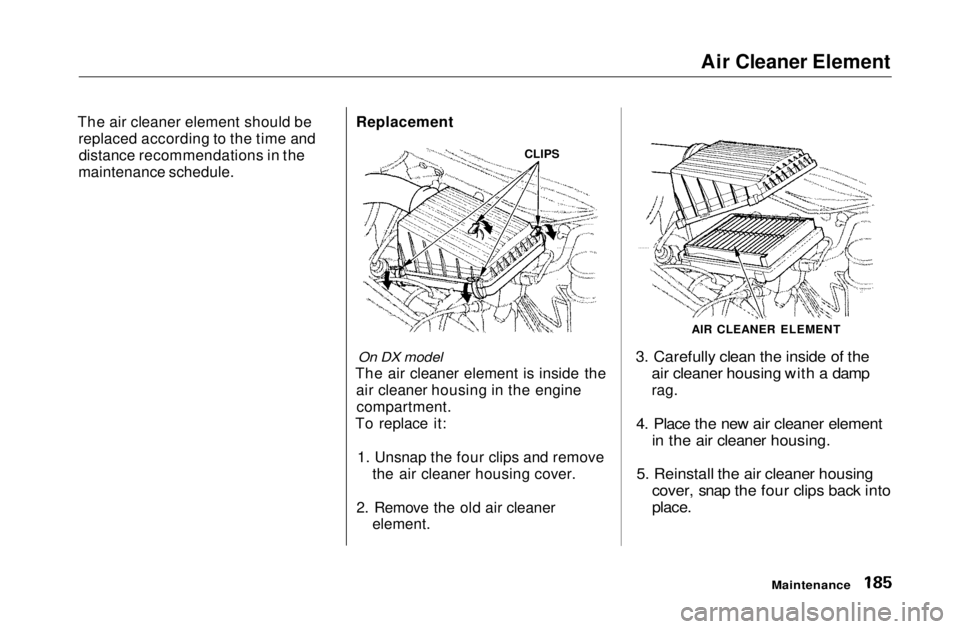
Air Cleaner Element
The air cleaner element should be replaced according to the time anddistance recommendations in the
maintenance schedule. Replacement
CLIPS
On DX model
The air cleaner element is inside the air cleaner housing in the enginecompartment.
To replace it:
1. Unsnap the four clips and remove the air cleaner housing cover.
2. Remove the old air cleaner element. AIR CLEANER ELEMENT
3. Carefully clean the inside of the air cleaner housing with a damp
rag.
4. Place the new air cleaner element in the air cleaner housing.
5. Reinstall the air cleaner housing cover, snap the four clips back into
place.
MaintenanceMain Menu Table of Contents s t
Page 185 of 269
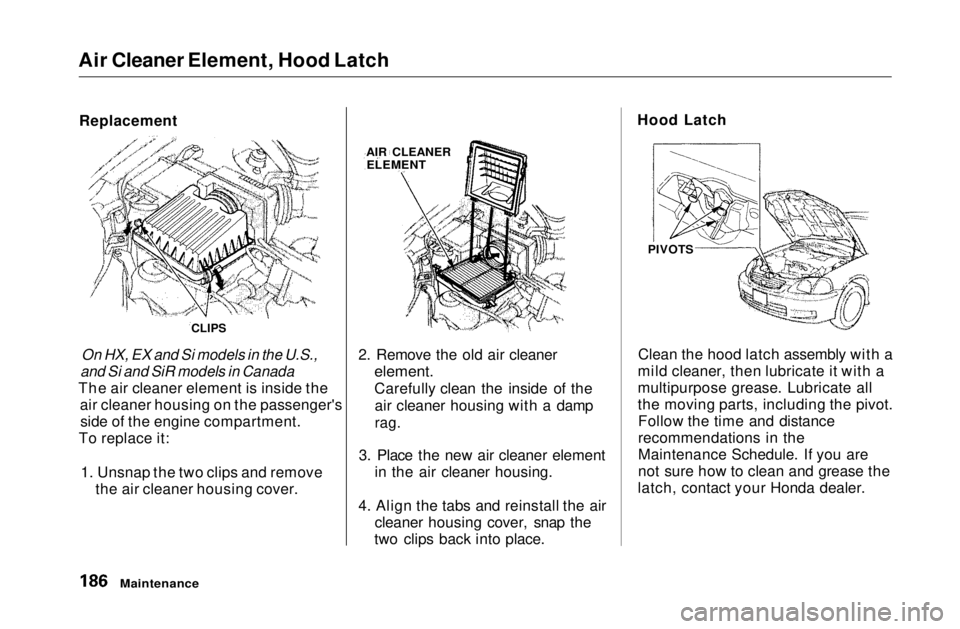
Air Cleaner Element, Hood Latch
Replacement
On HX, EX and Si models in the U.S.,
and Si and SiR models in Canada
The air cleaner element is inside the air cleaner housing on the passenger'sside of the engine compartment.
To replace it:
1. Unsnap the two clips and remove the air cleaner housing cover. 2. Remove the old air cleaner
element.
Carefully clean the inside of the
air cleaner housing with a damp
rag.
3. Place the new air cleaner element in the air cleaner housing.
4. Align the tabs and reinstall the air cleaner housing cover, snap the
two clips back into place. Hood Latch
Clean the hood latch assembly with a
mild cleaner, then lubricate it with a
multipurpose grease. Lubricate all
the moving parts, including the pivot. Follow the time and distance
recommendations in the
Maintenance Schedule. If you are
not sure how to clean and grease the
latch, contact your Honda dealer.
Maintenance
CLIPS
AIR CLEANER
ELEMENT
PIVOTSMain Menu Table of Contents s t
Page 186 of 269
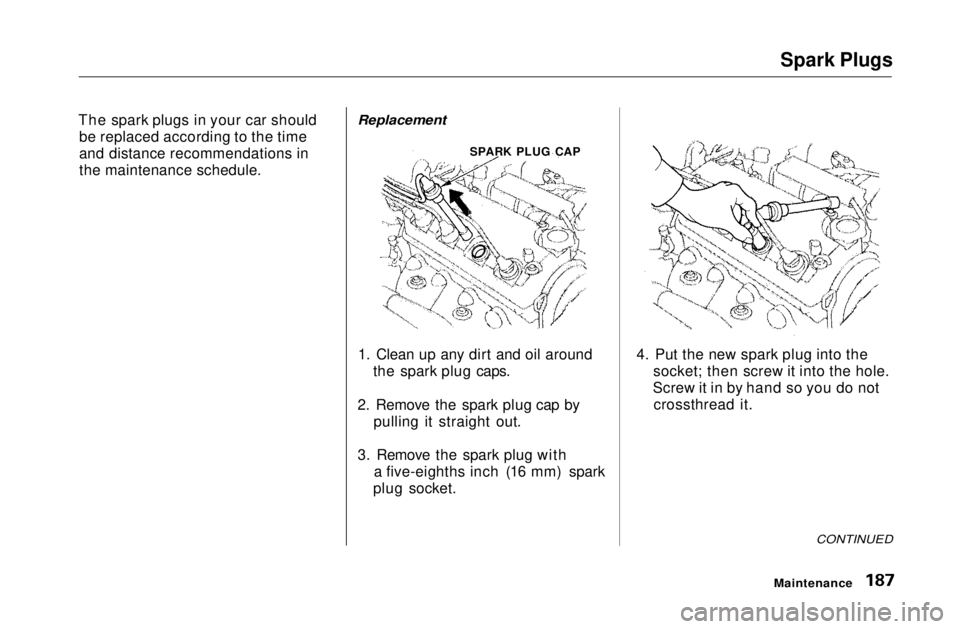
Spark Plugs
The spark plugs in your car should be replaced according to the time
and distance recommendations in
the maintenance schedule.
Replacement
1. Clean up any dirt and oil around the spark plug caps.
2. Remove the spark plug cap by pulling it straight out.
3. Remove the spark plug with a five-eighths inch (16 mm) spark
plug socket. 4. Put the new spark plug into the
socket; then screw it into the hole.
Screw it in by hand so you do not crossthread it.
CONTINUED
Maintenance
SPARK PLUG CAPMain Menu Table of Contents s t
Page 187 of 269
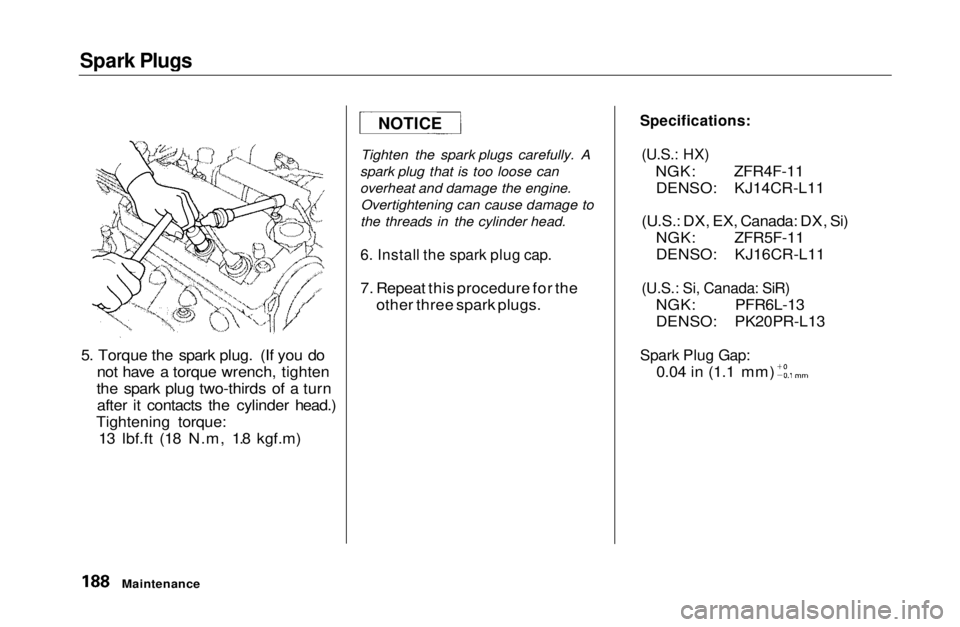
Spark Plugs
5. Torque the spark plug. (If you do not have a torque wrench, tighten
the spark plug two-thirds of a turn after it contacts the cylinder head.)
Tightening torque: 13 lbf.ft (18 N.m, 1.8 kgf.m) Tighten the spark plugs carefully. A
spark plug that is too loose can
overheat and damage the engine. Overtightening can cause damage to
the threads in the cylinder head.
6. Install the spark plug cap.
7. Repeat this procedure for the other three spark plugs.
Specifications:
(U.S.: HX)
NGK: ZFR4F-11DENSO: KJ14CR-L11
(U.S.: DX, EX, Canada: DX, Si) NGK: ZFR5F-11
DENSO: KJ16CR-L11
(U.S.: Si, Canada: SiR)
NGK: PFR6L-13
DENSO: PK20PR-L13
Spark Plug Gap:
0.04 in (1.1 mm)
Maintenance
NOTICEMain Menu Table of Contents s t
Page 188 of 269
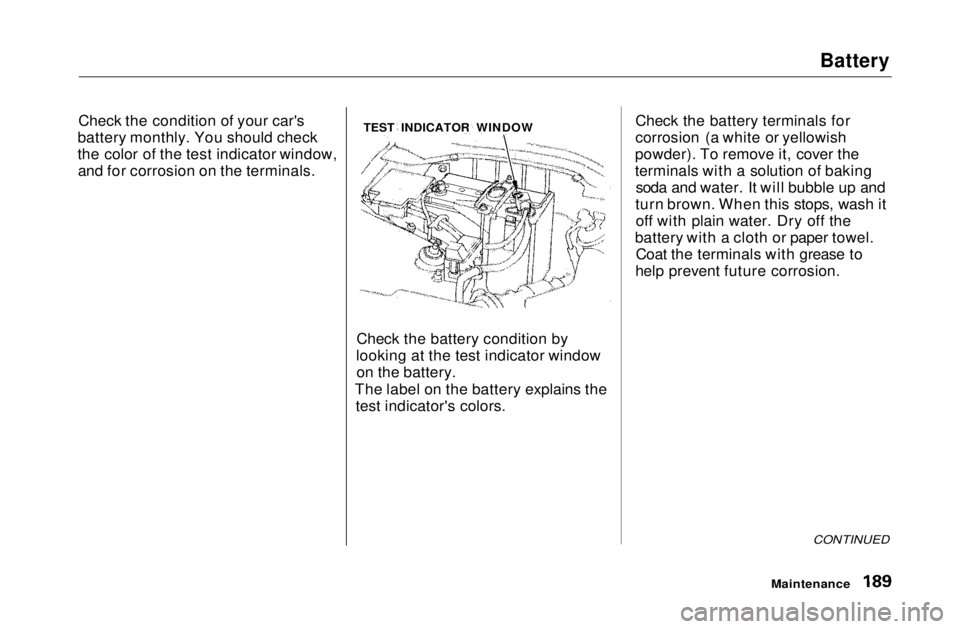
Battery
Check the condition of your car's
battery monthly. You should check
the color of the test indicator window, and for corrosion on the terminals.
Check the battery condition by
looking at the test indicator window on the battery.
The label on the battery explains the test indicator's colors. Check the battery terminals for
corrosion (a white or yellowish
powder). To remove it, cover the
terminals with a solution of baking soda and water. It will bubble up and
turn brown. When this stops, wash it off with plain water. Dry off the
battery with a cloth or paper towel. Coat the terminals with grease to
help prevent future corrosion.
CONTINUED
Maintenance
TEST INDICATOR WINDOWMain Menu Table of Contents s t
Page 189 of 269
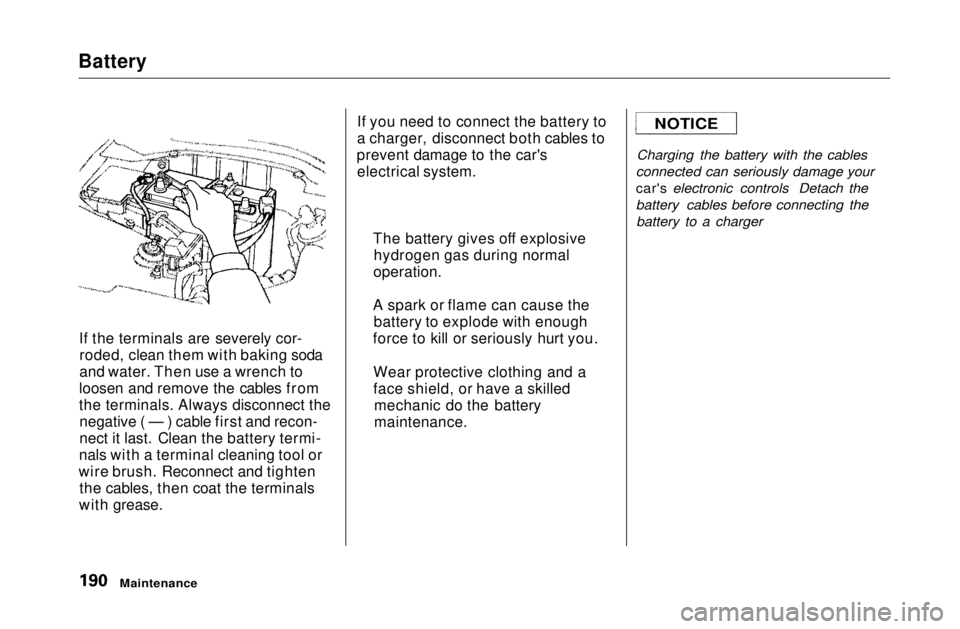
Battery
If the terminals are severely cor-roded, clean them with baking soda
and water. Then use a wrench to
loosen and remove the cables from
the terminals. Always disconnect the negative ( — ) cable first and recon-
nect it last. Clean the battery termi-
nals with a terminal cleaning tool or
wire brush. Reconnect and tighten the cables, then coat the terminals
with grease. If you need to connect the battery to
a charger, disconnect both cables to
prevent damage to the car's electrical system.
Charging the battery with the cables
connected can seriously damage your
car's electronic controls Detach the
battery cables before connecting the battery to a charger
Maintenance
NOTICE
The battery gives off explosive hydrogen gas during normal
operation.
A spark or flame can cause the battery to explode with enough
force to kill or seriously hurt you.
Wear protective clothing and a
face shield, or have a skilled mechanic do the battery
maintenance.Main Menu Table of Contents s t
Page 190 of 269

Wiper Blades
Check the condition of the wiper
blades at least every six months. Look for signs of cracking in the
rubber, or areas that are getting
hard. Replace the blades if you find
these signs, or they leave streaks and unwiped areas when used.
To replace the blade:1. Raise the wiper arm off the windshield. 2. Disconnect the blade assembly
from the wiper arm by pushing inthe lock tab. Hold it in while you
push the blade assembly toward
the base of the arm.
CONTINUED
Maintenance
WIPER ARMS
LOCKTABMain Menu Table of Contents s t